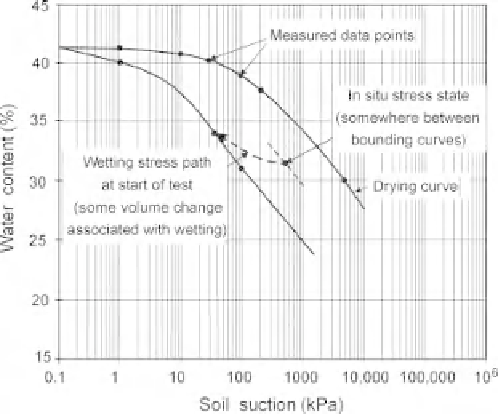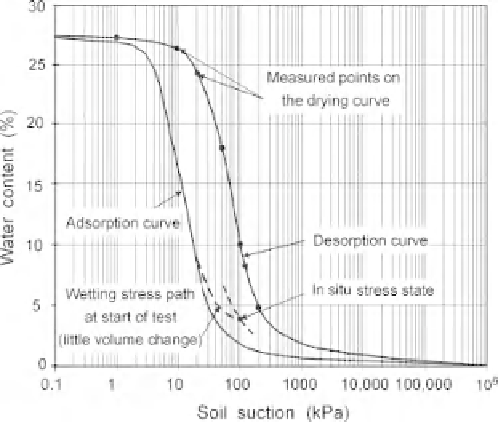Environmental Engineering Reference
In-Depth Information
plate apparatus and allowed to imbibe water for one or more
days. The initial suction in the soil is assumed to be zero
once the soil has fully imbibed water. The stress state of
the soil has now been altered from in situ conditions and
the stress path followed during setup of the soil specimen is
illustrated in Fig. 5.45. The specimen may undergo a change
in volume if the soil has considerable clay content.
Once the specimen has fully imbibed water, the test data
for the SWCC can be obtained by applying a series of
applied suction values. Each applied soil suction should
be maintained until the specimen has reached an equilib-
rium state (i.e., no further release of water). The drying
(or desorption) bounding curve of the water content ver-
sus soil suction relationship is most commonly measured.
Figure 5.46 illustrates the change in state experienced by a
sand soil as it is given access to water prior to testing.
Understanding the changes in stress state that occur during
the setup of the soil specimen assists in the interpretation of
the test data. It is clear that the laboratory SWCC data do
not represent a soil being dried from its in situ stress state.
Rather, the laboratory-measured SWCC data corresponds to
a particular test procedure that does not currently represent
in situ conditions and may not represent later conditions.
However, the SWCC has proven to be of significant value
as a guide for the estimation of unsaturated soil property
functions.
The test procedure used to measure the SWCC is based
on a long history of measurements in agriculture-related dis-
ciplines. It could be reasoned that there might be merit in
modifying the test procedure to more accurately represent
in situ total stress conditions when performing a labora-
tory SWCC test. The possibility of applying total stresses
has been taken into consideration in the design of recent
laboratory testing apparatuses.
Figure 5.46
Stress path followed during initial stages of pressure
plate test on sand.
Geotechnical engineers have been successful in using
SWCC data obtained using test procedures developed in
agriculture-related disciplines. It has also been possible
to successfully use existing data sets for the estimation
of unsaturated soil properties (Fredlund, 1998b). Most
of the existing data represent the drying or desorption
curve subsequent to saturating a soil specimen. Records
should also be kept related to details of the soil specimen
preparation and test procedure (Fig. 5.47). It is important
for the geotechnical engineer to know whether the soil has
been initially remolded near the LL, initially compacted
near PL-conditions, or
tested from an undisturbed or
disturbed sample state.
5.5.3 Desaturation Stages along SWCC
The SWCC laboratory test procedure commences with the
saturation of the soil specimen. The soil then begins to
Preparation of the soil specimen for
laboratory measurement of SWCC
Remolded soil at
slurry conditions
Undisturbed
sample
Compacted sample
Characteristic
:
- May contain
macrostructure
and cracks
- Difficult to
estimate SWCC
without
measurement
Characteristic:
- Homogeneous
soil structure
- Uniformly
graded
pore sizes
Characteristic:
- Induced artificial
soil structure
- Bimodal void
spaces at
increased
clay content
Figure 5.45
Stress path followed at start of pressure plate test on
clay soil.
Figure 5.47
Characteristics associated with initial conditions of
soil specimen for SWCC test.






















Search WWH ::

Custom Search